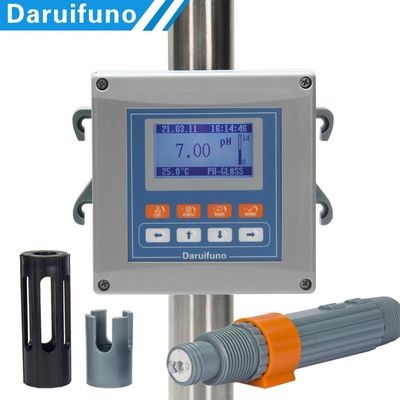NTC10K - 10~150℃ Online PH ORP Analyzer for Aquaculture Water Treatment
Brief introduction
PH/ORP gauges has a temperature detection and temperature compensation function, supporting pH electrodes with temperature to measure temperature changes in aqueous solutions. It is a patented temperature drift compensation technology, which makes the instrument more stable and accurate in all kinds of environments.
The PH/ORP gauges use salt-bridged primary battery electrodes (PH electrodes) to detect changes in the concentration of hydrogen ions in the solution, which affect the electrode level. It is usually made of glass and commonly known as PH glass electrode measurement. Mathematic defines pH as a commonly used congenital negative value for the concentration of hydrogen ions, i.e. pH=-lg[H⁺]
Applications of Online PH ORP gauge
1 Water treatment monitoring: drinking water surface water quality groundwater environmental sewage discharge monitoring urban drainage network monitoring
2 Industrial process monitoring and dosing control treatment: chemical petroleum paper food medicine electroplating PCB manufacture
Technical Parameters of Online PH ORP gauge
| Model |
APX2-G4A |
| Software version |
DRFN PH Analysis software V1.0 |
| Sensor Input PH |
Glass PH sensor. |
| Sensor Input ORP |
Redox sensor (platinum / gold sensor) |
| Sensor Input TEMP |
PT1000 or NTC10K |
|
Sensor Input
Ground Electrode
|
Combination electrode with ground rod |
| Range / Resolution PH |
-2~16pH / 0.01pH |
| Range / Resolution ORP |
±2000mV / 1mV |
|
Range Resolution
Measure Temperature
|
-10~150℃ / 0.1℃(14~302℉ / 0.1℉) |
| Performance Accuracy |
0.1% of span or PH: ±0.02pH /ORP: ±2mV, select larger one. |
| Performance Stability |
0.05% of span every 24 hours, no accumulation. |
|
Performance
Repeat-ability
|
Better than 0.1% of span |
| Electrode Self-diagnosis |
The zero and slope of the electrodes are diagnosed during calibration and maintenance. If the screen prompts maintenance or replacement, the buzzer prompts briefly. |
| Relay Control |
2 SPST relays: the maximum load is 3A/250VAC. |
| Analog Current Output |
Two 0/4 ~ 20mA currents; accuracy 0.00025 (16 bits); Maximum load 1000 Ω. |
|
Communication Mode
|
Two-wire RS485 interface, communication protocol: MODBUS RTU
Supports JSON (JavaScript Object Notation) text data formats.
|
| Display Language |
128 x 64 dots; English / Chinese / Other languages |
|
Time History/
Data Record
|
Record in years, months, dates, hours, minutes and seconds,
Keep 14,000 historical measurements and last 100 maintenance data
|
| Overall Dimensions |
144*144*120mm Panel Hole dimension 138*138mm |
| Power |
AC power supply 100~240VAC |
| Power Consumption |
10W |
Advantage of Online PH ORP gauge

PH/ORP gauges can be connected to a variety of traditional PH/T or ORP combination electrodes. It has the patented temperature detection and temperature drift compensation technology
The PH/ORP online gauge for differential signal input is compatible with ground rod pH sensors to solve problems like reference junction potential and sensor ground loops.
The PH ORP gauge works accurately in years, months, dates, hours, minutes and seconds, it records the measurement data on time to form a consultable historical data. The PH ORP gauge can record up to 14,000 historical measurements. The recording interval is freely set by the user. User maintenance are also recorded and the last 100 maintenance data are saved to help us find and analyze the cause of the instrument's abnormal operation.
Analog pH (acidity-base) and ORP (oxidation-reduction potential) sensors are commonly used in environments where liquid properties need to be monitored. These environments include but are not limited to:
Water treatment: In water supply systems, sewage treatment plants or other water treatment facilities, monitoring the pH and redox potential of water is very important to ensure that water quality is acceptable and safe.
Chemical industry: In the chemical industry, monitoring the pH and redox potential of reactants can help control and optimize chemical processes to ensure the stability and quality of production.
Food and Beverages: In food processing and beverage production, monitoring the pH and redox potential of liquids helps ensure product quality and hygienic safety.
Swimming pools and hot springs: Monitoring the pH value of water bodies such as swimming pools and hot springs is one of the important means to maintain clean and safe water quality.
Environmental Monitoring: In environmental science and ecology, monitoring the pH and redox potential of soil or water helps assess the health of the environment.
These sensors play a key role in the above environments. By monitoring the pH value and redox potential of liquids in real time, they can help people control and adjust the properties of liquids, and take necessary measures in a timely manner to maintain the quality and quality of the environment, products or processes. stability.

 Your message must be between 20-3,000 characters!
Your message must be between 20-3,000 characters! Please check your E-mail!
Please check your E-mail!  Your message must be between 20-3,000 characters!
Your message must be between 20-3,000 characters! Please check your E-mail!
Please check your E-mail! 






